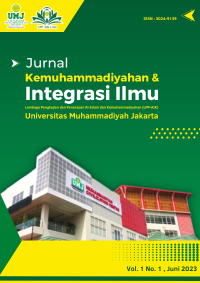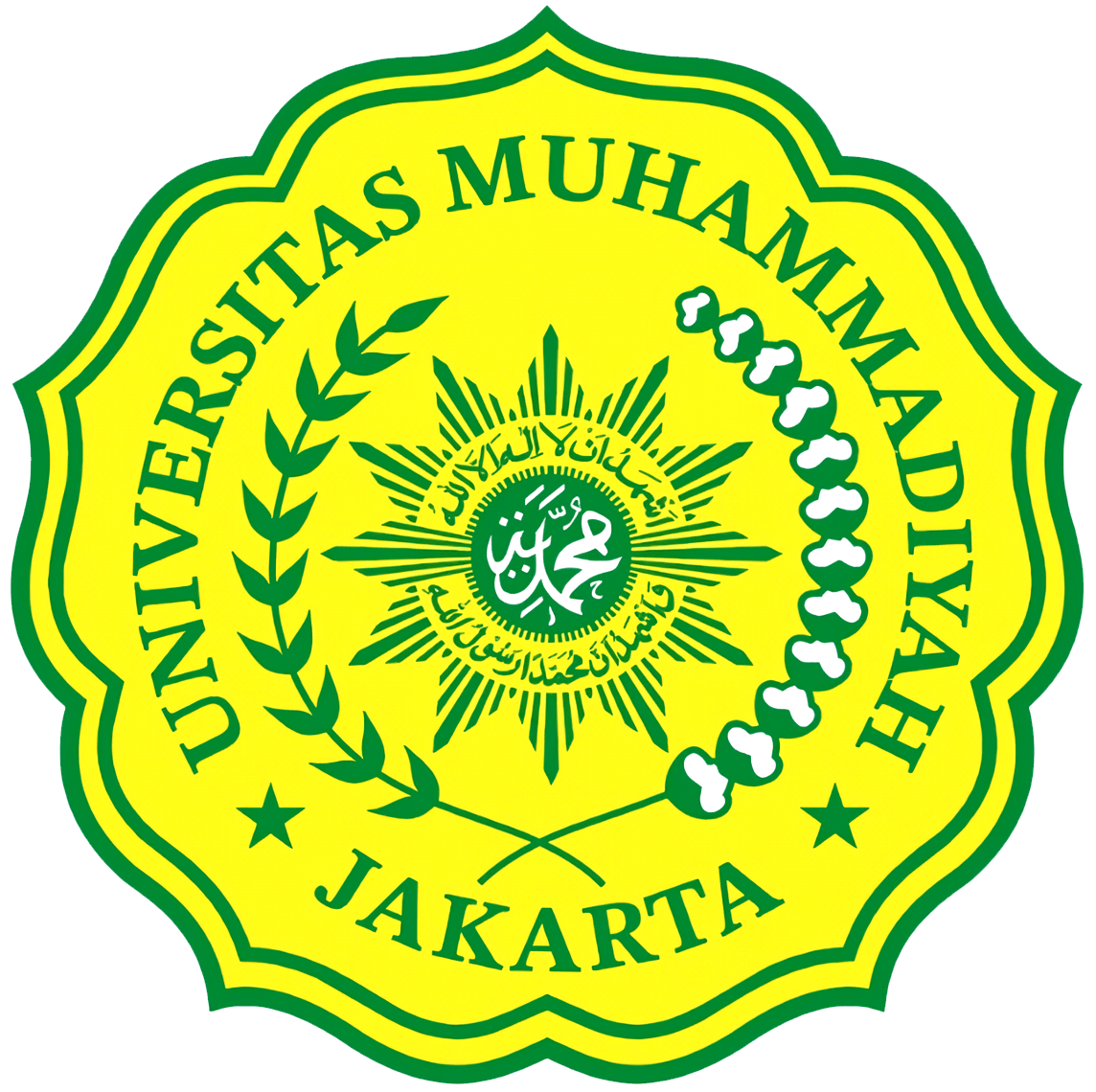PENGOLAHAN AIR LIMBAH INDUSTRI: PENDEKATAN METODE ADSORPSI DALAM PERSPEKTIF ISLAM BERKEMAJUAN
DOI:
https://doi.org/10.24853/jkii.2.2.213-225Abstract
Polusi air akibat air limbah industri semakin mengkhawatirkan, jika hal tersebut tidak dapat ditangani dengan baik maka dapat menimbulkan kerusakan lingkungan. Dalam prespektif islam berkemajuan diperlukannya adaptasi dan kemampuan memecah masalah yang terjadi untuk menjaga kemaslahatan umat. Diperlukan solusi dalam pengolahan air limbah industri yang efektif dan berkelanjutan, sehingga kemaslahatan umat dan lingkungan tetap terjaga. Terdapat berbagai macam metode pengolahan air limbah yang telah dilakukan salah satunya metode adsorpsi. Metode adsorpsi terbukti mampu menghilangkan berbagai jenis polutan dengan efisiensi tinggi, bahkan hingga 100% untuk jenis polutan tertentu. Dengan memanfaatkan material seperti limbah organik dan anorganik sebagai adsorben, metode ini menjadi fleksibel, hemat energi, dan ramah lingkungan. Dari perspektif Islam, metode ini mendukung prinsip menjaga keseimbangan alam sebagai wujud tanggung jawab manusia sebagai khalifah di bumi. Namun, terdapat beberapa tantangan dalam implementasi metode ini seperti kebutuhan uji skala besar dan pengembangan adsorben yang lebih ekonomis. Penelitian lebih lanjut dapat mengoptimalkan metode ini untuk mendukung pengelolaan limbah industri yang lebih efektif. Metode adsorpsi bukan hanya solusi teknis, tetapi juga mencerminkan tanggung jawab moral terhadap lingkungan, menjadikannya pendekatan penting dalam menjaga keberlanjutan ekosistem dan makhluk hidup di bumi ini.References
Adawiah, S. R., Sutarno, & Suyanta. (2020). Indonesian Journal of Chemical Research Adsorption-Desorption Studies of Phosphate on CTAB Modified Bentonite Indonesian Journal of Chemical Research Adsorption-Desorption Studies of Phosphate on CTAB Modified Bentonite. Indonesian Journal of Chemical Research Http://Ojs3.Unpatti.Ac.Id/Index.Php/Ijcr, 8(2), 125–136. https://doi.org/10.30598/ijcr.2020.8-sra
Adnan, M., Xiao, B., Ali, M. U., Xiao, P., Zhao, P., Wang, H., & Bibi, S. (2024). Heavy metals pollution from smelting activities: A threat to soil and groundwater. Ecotoxicology and Environmental Safety, 274, 116189. https://doi.org/10.1016/j.ecoenv.2024.116189
Ariesman M. (2018). Efisiensi Air di Pesantren melalui Penerapan Sunnah Nabi dan Teknologi Terapan. Nukhbatul ’Ulum, 4(1), 391–404. https://doi.org/10.36701/nukhbah.v4i1.32
Arum Sari, D. F. P., & Retnaningsih, D. A. (2022). Keutamaan Orang Berilmu Dalam Al-Qur’an Surat Al-Mujadalah Ayat 11. Tarbiya Islamica, 10(2), 118–129. https://doi.org/10.37567/ti.v10i2.2252
Badu, R. R., Umadji, N. I. R., Ibrahim, S. R. I., & A, A. A. M. S. (2024). Pengolahan Limbah Cair Tahu dengan Metode Adsorpsi Menggunakan Fly Ash dan Bottom Ash dalam Menurunkan Parameter Amonia. Al-Ard: Jurnal Teknik Lingkungan, 10(1), 39–44. https://doi.org/10.29080/alard.v10i1.2174
Borhade, A. V., Kshirsagar, T. A., & Dholi, A. G. (2017). Eco-Friendly Synthesis of Aluminosilicate Bromo Sodalite from Waste Coal Fly Ash for the Removal of Copper and Methylene Blue Dye. Arabian Journal for Science and Engineering, 42, 4479–4491. https://doi.org/10.1007/s13369-017-2759-9
Chen, B., Wang, M., Duan, M., Ma, X., Hong, J., Xie, F., Zhang, R., & Li, X. (2019). In search of key: Protecting human health and the ecosystem from water pollution in China. Journal of Cleaner Production, 228, 101–111. https://doi.org/10.1016/j.jclepro.2019.04.228
Chi, T., Zuo, J., & Liu, F. (2017). Performance and mechanism for cadmium and lead adsorption from water and soil by corn straw biochar. Frontiers of Environmental Science & Engineering, 11(2), 15. https://doi.org/10.1007/s11783-017-0921-y
Chowdhary, P., Bharagava, R. N., Mishra, S., & Khan, N. (2020). Role of Industries in Water Scarcity and Its Adverse Effects on Environment and Human Health. Environmental Concerns and Sustainable Development, 1(1), 235–256. https://doi.org/10.1007/978-981-13-5889-0_12
Duan, P., Yan, C., Zhou, W., & Ren, D. (2016). Development of fly ash and iron ore tailing based porous geopolymer for removal of Cu(II) from wastewater. Ceramics International, 42(12), 13507–13518. https://doi.org/10.1016/j.ceramint.2016.05.143
Dutta, D., Arya, S., & Kumar, S. (2021). Industrial wastewater treatment: Current trends, bottlenecks, and best practices. Chemosphere, 285(May), 131245. https://doi.org/10.1016/j.chemosphere.2021.131245
Fan, H., Chen, D., Ai, X., Han, S., Wei, M., Yang, L., Liu, H., & Yang, J. (2018). Mesoporous TiO2 coated ZnFe2O4 nanocomposite loading on activated fly ash cenosphere for visible light photocatalysis. RSC Advances, 8(3), 1398–1406. https://doi.org/10.1039/C7RA11055C
Golbad, S., Khoshnoud, P., & Abu-Zahra, N. (2017). Hydrothermal synthesis of hydroxy sodalite from fly ash for the removal of lead ions from water. International Journal of Environmental Science and Technology, 14(1), 135–142. https://doi.org/10.1007/s13762-016-1133-x
Gollakota, A. R. K., Munagapati, V. S., Volli, V., Gautam, S., Wen, J. C., & Shu, C. M. (2021). Coal bottom ash derived zeolite (SSZ-13) for the sorption of synthetic anion Alizarin Red S (ARS) dye. Journal of Hazardous Materials, 416, 125925. https://doi.org/10.1016/j.jhazmat.2021.125925
Harimu, L., Haetami, A., Sari, C. P., Haeruddin, & Nurlansi. (2020). Perbandingan Kemampuan Aerasi Sembur (Spray) dengan Metode Adsorpsi Menggunakan Adsorben Serbuk Kulit Buah Kakao untuk Menurunkan Kadar Besi dan Mangan Pada Air Sumur Gali. Indonesian Journal of Chemical, 8(2), 137–143. https://doi.org/10.30598//ijcr.2020.8-hrm
Hendra, M., & Rezi, M. (2021). Konsep Penciptaan Bumi dalam al-Qur’an (Studi Terhadap QS. al-Anbiya’ [21]: 30) Menurut Hamka dalam Tafsir al-Azhar. Jurnal Tafsere, 9(1), 92–121. https://doi.org/10.24252/jt.v9i1.30988
Hu, Q., Lan, R., He, L., Liu, H., & Pei, X. (2023). A critical review of adsorption isotherm models for aqueous contaminants: Curve characteristics, site energy distribution and common controversies. Journal of Environmental Management, 329, 117104. https://doi.org/https://doi.org/10.1016/j.jenvman.2022.117104
Indah, D. R. (2020). ADSORPSI LOGAM TEMBAGA (Cu) PADA KARBON BAGGASE TERAKTIVASI NATRIUM HIDROKSIDA (NaOH). Jurnal Ilmiah IKIP Mataram, 7(1), 20–28. https://e-journal.undikma.ac.id/index.php/jiim/article/view/3205
Italiana, N. R., & Hafsari, T. D. (2023). Tanggung Jawab Manusia Sebagai Khalifah Di Bumi Untuk Menjaga Dan Melestarikan Lingkungan Alam. Journal Islamic Education, 1(3), 288–297. https://maryamsejahtera.com/index.php/Education/index
Jaafar, M., Alatabe, A., Faris, H. A., & Husham, H. (2023). Natural Biosorbent for Oil Adsorption from Produced Water by Sedge Cane. Journal of Ecological Engineering, 24(10), 67–76. https://doi.org/10.12911/22998993/166310 ISSN
Jit, B., Chakraborty, A., & Sehgal, R. (2023). A systematic review of industrial wastewater management : Evaluating challenges and enablers. Journal of Environmental Management, 348(October), 119230. https://doi.org/10.1016/j.jenvman.2023.119230
Kholil, M. (2024). Khalifah Dalam Melestarikan Lingkungan Hidup (Kajian Ayat Ekologis Persfektif Mufasir Indonesia). Graduasi: Jurnal Mahasiswa, 1(1), 71–79. https://doi.org/10.33650/graduasi.v1i1.8238
Lestari, I., Mahraja, M., Farid, F., Gusti, D. R., & Permana, E. (2020). PENYERAPAN ION Pb(II) MENGGUNAKAN ADSORBEN DARI LIMBAH PADAT LUMPUR AKTIF PENGOLAHAN AIR MINUM. Chemistry Progress, 13(2), 68–76. https://doi.org/10.35799/cp.13.2.2020.31391
Lin, L., Yang, H., & Xu, X. (2022). Effects of Water Pollution on Human Health and Disease Heterogeneity: A Review. Frontiers in Environmental Science, 10, 880246. https://doi.org/10.3389/fenvs.2022.880246
Lubis, R. A. F., Nasution, H. I., & Zubir, M. (2020). Production of Activated Carbon from Natural Sources for Water Purification. Indonesian Journal of Chemical Science and Technology, 3(2), 67–73. https://doi.org/https://doi.org/10.24114/ijcst.v3i2.19531
Mays, Z. E. A., Adsorbent, S., Mays, Z. E. A., Zulfania, F., Fathoni, R., & Nur, A. M. (2022). Kemampuan Adsorbsi Logam Berat Zn Dengan Menggunakan Adsorben Kulit Jagung (Zea Mays). Jurnal Chemurgy, 6(200), 65–69. https://doi.org/http://dx.doi.org/10.30872/cmg.v6i2.8060
Mubarok, M. R., & Nasrulloh. (2024). INTERPRETASI KONTEKSTUAL DALAM MENANGANI KRISIS LINGKUNGAN KAJIAN SURAT AL-BAQARAH AYAT 11 DAN 205 DALAM TAFSIR IBNU KATSIR. Holistik Analisis Nexus, 1(10), 45–51. https://doi.org/10.62504/nexus929
Muhammad, A. (2022). Urgensi Pelestarian Lingkungan Hidup Dalam Al-Qur’an. Jurnal Pilarr : Jurnal Kajian Islam Kontemporer, 13(1), 67–87. https://journal.unismuh.ac.id/index.php/pilar/article/view/7763
Rahayuningsih, M., & Utami, N. R. (2017). Sekolah Muhammadiyah Kota Semarang Menuju Greenschool. Indonesian Journal of Conservation, 06(01), 31–35. https://doi.org/10.15294/ijc.v6i1.12528
Ramli, M., Muslim, B., & Fajriah, S. N. (2019). INTEGRASI PENCEMARAN LOGAM BERAT DAN ISLAMMENGGUNAKAN METODE 4-STMD. Jurnal As-Salam, 3(3), 102–115. https://doi.org/10.37249/as-salam.v3i3.141
Rathi, B. S., & Kumar, P. S. (2021). Application of adsorption process for effective removal of emerging contaminants from water and wastewater. Environmental Pollution, 280, 116995. https://doi.org/10.1016/j.envpol.2021.116995
Rustiadi, E., Pravitasari, A. E., Setiawan, Y., Mulya, S. P., Pribadi, D. O., & Tsutsumida, N. (2021). Impact of continuous Jakarta megacity urban expansion on the formation of the Jakarta-Bandung conurbation over the rice farm regions. Cities, 111, 103000. https://doi.org/10.1016/j.cities.2020.103000
Satyam, S., & Patra, S. (2024). Innovations and challenges in adsorption-based wastewater remediation : A comprehensive review. Heliyon, 10(9), e29573. https://doi.org/10.1016/j.heliyon.2024.e29573
Setiawan, I., Napitupulu, M., & Walanda, D. (2018). Biocharcoal dari Kulit Rambutan (Nephelium lappaceum L.) sebagai Adsorben Zink dan Tembaga. Jurnal Akademika Kimia, 7, 193. https://doi.org/10.22487/j24775185.2018.v7.i4.11944
Setiorini, I. A., Mardiana, V., Prakasa, M. W., & Sujarwo, A. (2018). Pengaruh Massa Adsorben Karbon Aktif Batubara Terhadap Penyerapan Kandungan Nilai COD Dan TOC Dalam Limbah Kain Jumputan Pada Rancang Bangun Alat Adsorber. Jurnal Teknik Patra Akademika, 9(1), 14–28. https://doi.org/https://doi.org/10.52506/jtpa.v9i01.66
Shakya, A., & Agarwal, T. (2019). Removal of Cr ( VI ) from water using pineapple peel derived biochars : Adsorption potential and re-usability assessment. Journal of Molecular Liquids, 293, 111497. https://doi.org/10.1016/j.molliq.2019.111497
Shen, Z., Zhang, Y., McMillan, O., Jin, F., & Al-Tabbaa, A. (2017). Characteristics and mechanisms of nickel adsorption on biochars produced from wheat straw pellets and rice husk. Environmental Science and Pollution Research, 24(14), 12809–12819. https://doi.org/10.1007/s11356-017-8847-2
Shu, Y., Wei, X., Fang, Y., Lan, B., & Chen, H. (2015). Removal of sulfuric acid mist from lead-acid battery plants by coal fly ash-based sorbents. Journal of Hazardous Materials, 286, 517–524. https://doi.org/10.1016/j.jhazmat.2015.01.014
Silva, J. A. (2023). Wastewater Treatment and Reuse for Sustainable Water Resources Management: A Systematic Literature Review. Sustainability (Switzerland), 15(14). https://doi.org/10.3390/su151410940
Suryati, A., Nurmila, N., & Rahman, C. (2019). Konsep Ilmu Dalam Al-Qur’an: Studi Tafsir Surat Al-Mujadilah Ayat 11 Dan Surat Shaad Ayat 29. Al Tadabbur Jurnal Ilmu Alquran Dan Tafsir, 04(02), 217–227. https://doi.org/10.30868/at.v4i02.476
Thirumalai, K., Balachandran, S., & Swaminathan, M. (2016). Superior photocatalytic, electrocatalytic, and self-cleaning applications of Fly ash supported ZnO nanorods. Materials Chemistry and Physics, 183, 191–200. https://doi.org/10.1016/j.matchemphys.2016.08.018
Wardhana, B. S., Hanum, F. F., Mufrodi, Z., Kimia, M. T., Industri, F. T., Dahlan, U. A., Ahmadyani, J., & Yogyakarta, D. I. (2024). REVIEW : EFFECT OF MATERIAL CHARACTERISTICS , AND PROCESS CONDITIONS IN REDUCING GASEOUS POLLUTANTS USING FLY ASH ( FA ) - BASED ADSORBENT. Jurnal Sains Dan Seni ITS, 14(4), 169–178. https://doi.org/10.31938/jsn.v14i4
Wu, H., Gai, Z., Guo, Y., Li, Y., Hao, Y., & Lu, Z. N. (2020). Does environmental pollution inhibit urbanization in China? A new perspective through residents’ medical and health costs. Environmental Research, 182, 109128. https://doi.org/10.1016/j.envres.2020.109128


1.png)






1.png)

2.png)


